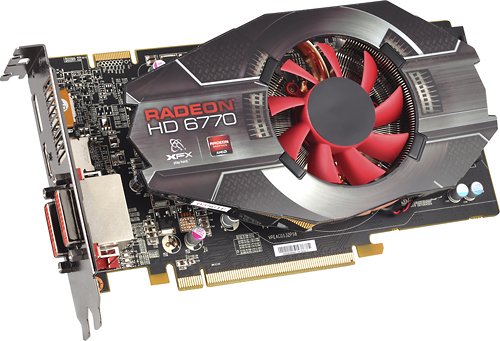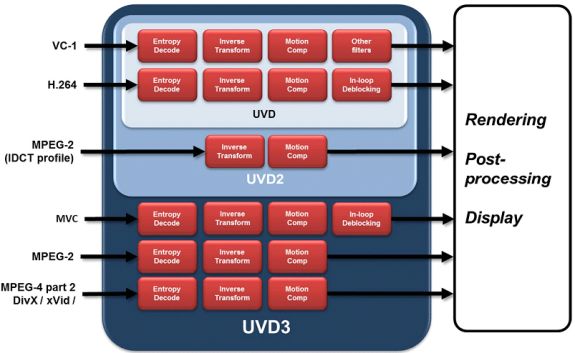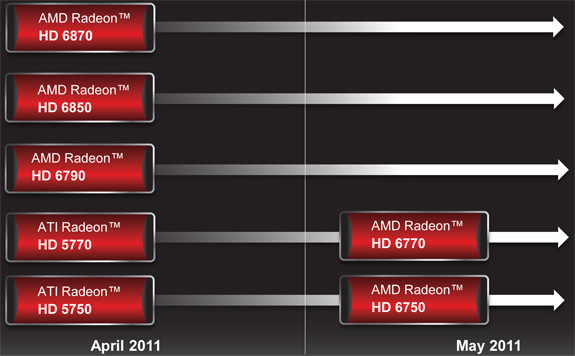AMD’s Radeon HD 6770 & Radeon HD 6750: The Retail Radeon 5700 Rebadge
by Ryan Smith on April 28, 2011 12:01 AM ESTWe haven’t talked about it beyond a passing comment, but AMD still has some Radeon 6000 series cards that are OEM-only. We are of course referring to the Radeon HD 6770 and Radeon HD 6750, AMD’s Juniper-powered 5770 & 5750 rebadges for OEMs. While we’ve only recently seen the rest of the Northern Islands lineup launch in the retail space, in the OEM space the last-generation Juniper GPU has been filling out AMD’s lineup between Turks (6500/6600) and Barts (6800) based video cards.
The rationale for OEM space is rather straightforward: OEMs want/need something new to sell. More RAM, a Sandy Bridge CPU, a SSD – their 2011 computers need to look better than their 2010 computers, as they certainly don’t want to be seen as selling last year’s model for anything less than a steep discount. It was perhaps a foolish hope that these shenanigans would remain in the OEM market, as so far AMD has continued to keep the 5770 and 5750 even after the rest of Northern Islands has launched. But here we are, out with the old and in with the old: the 5770 and 5750 are getting rebadged in retail. Say hello to the Radeon HD 6770 and Radeon HD 6750.
| AMD Radeon HD 6770 | AMD Radeon HD 5770 | AMD Radeon HD 6750 | AMD Radeon HD 5750 | |
| Stream Processors | 800 | 800 | 720 | 720 |
| Texture Units | 40 | 40 | 36 | 36 |
| ROPs | 16 | 16 | 16 | 16 |
| Core Clock | 850MHz | 850MHz | 700MHz | 700MHz |
| Memory Clock | 1.2GHz (4.8GHz data rate) GDDR5 | 1.2GHz (4.8GHz data rate) GDDR5 | 1.15GHz (4.6GHz data rate) GDDR5 | 1.15GHz (4.6GHz data rate) GDDR5 |
| Memory Bus Width | 128-bit | 128-bit | 128-bit | 128-bit |
| VRAM | 1GB | 1GB | 1GB | 1GB |
| FP64 | N/A | N/A | N/A | N/A |
| Transistor Count | 1.04B | 1.04B | 1.04B | 1.04B |
| Manufacturing Process | TSMC 40nm | TSMC 40nm | TSMC 40nm | TSMC 40nm |
| Price Point | ? | ~$110 | ? | ~$110 |
There’s really no way to sugarcoat it, and even AMD isn’t really trying. It’s the same Juniper GPU on the same boards with the same clocks, the same power requirements, and the same performance. The only thing different between a 5700 series card and its 6700 series counterpart is the sticker on the card, the BIOS, and quite possibly the price.

Image Courtesy Best Buy

Image Courtesy Newegg
However to be fair to AMD, they have at least made some effort to improve on the 6700 series over the 5700 series through the BIOS. As you may recall, one of the big differences for the 6000 series over the 5000 series is that the 6000 series got HDMI 1.4a support, along with a UVD3 video decoder that was capable of decoding the additional resolutions and bitrates Blu-Ray 3D’s MVC(H.264) profiles require. These changes have been backported to Juniper to some extent.
UVD2.2 is fast enough to process MVC, so now the 6700 series can decode Blu-Ray 3D. Without any hardware on hand we can’t specifically test this, but we suspect AMD may have introduced a new PowerPlay state (or edited an existing one) to further ramp up Juniper’s core clocks when playing MVC content, as this would be the most practical way to increase the max bitrate UVD2.2 can handle, if indeed it couldn’t handle MVC bitrates at the usual core clocks. Update: AMD has confirmed our theory. In fact the UVD3 also have a Blu-Ray 3D PowerPlay state, which means UVD2 and UVD3 may be more similiar than we once thought.
Meanwhile HDMI 1.3 and HDMI 1.4a both have the same bandwidth requirements, so now the 6700 series is HDMI 1.4a capable through some BIOS magic – although we haven’t been able to get confirmation that this support extends beyond support for the frame-packed formats required for HDMI 3D, or in other words it may not support 2K x 4K resolutions and other features normally associated with HDMI 1.4a. Update: AMD confirmed that the 6700 series only supports the HDMI 3D portions of the HDMI 1.4a spec. Apparently this is consistent with Northern Islands, whcih doesn't support 2K x 4K resolutions over HDMI either.

The good news here is that we’re not immediately aware of any reason why these features can’t be fully backported to existing 5700 series cards. Although AMD technically refers to UVD2.2 having “firmware”, as far as we know everything is contained in the video card’s BIOS. If this is the case, then for any 5700 series designs being recycled for the 6700 series, it should be easy to use the 6700 series BIOS. Of course this wouldn’t be something AMD supports.
Ultimately AMD considers this rebadging a necessity to some degree. While everyone is free to speculate on whether there are ulterior motives, what is clear is that the 5700 series created a branding problem for AMD: the 5000 series was launched before ATI was rebranded AMD. So the 5770 and 5750 are still technically “ATI” cards, this being nearly 8 months after ATI was fully rebranded to be part of AMD. At the same time this makes AMD’s product stack consistent from top to bottom for both retail and OEMs: every current card from the 6450 to the 6990 is now a 6000 series cards. It’s not a particularly good reason, but it is what it is.

Ultimately our biggest concern at this point is pricing. AMD tells us that 6700 series pricing will be consistent with 5700 series pricing, but we have our doubts. 5770 has actually been really good – it regularly goes on sale for as low as $95, so if you don’t mind a MIR and the choice of only a couple of vendors, you’ve been able to grab a 5770 for under $100. This is cheaper than the 5750 most of the time, never mind what it does to the 6670 and NVIDIA’s lineup. What is NVIDIA’s lineup? The slightly faster GTX 550 Ti at $125+, and the 5750-like GTS 450 at $90+. Compared to everything AMD and NVIDIA, the 5770 is a very good deal; and this is why we’re concerned about the pricing.
| Radeon HD 5700 Series Price History | |||||
| Launch | Today | Difference | |||
| Radeon HD 5770 | $160 | Approx $110 | -$50 | ||
| Radeon HD 5750 | $130 | Approx $110 | -$20 | ||
We hope to be proven wrong here, but at this point in time there’s little reason for AMD and their partners to sell $100 5770s when there’s no competitive pressure to do so. A good bargain is another name for a product bringing in less profit than it should, and in the cut-throat semiconductor industry you usually need to grab what you can when you can. The concern we have is that it’s as good a time as any to realign 5770 prices with the competitive market and AMD’s product stack – it’s time for a price hike. There is no doubt in my mind that the first 6700 cards will cost more than the cheapest 5700 cards. The only question is whether prices will come back down once stores are fully stocked with 6700 cards as they are today with 5700 cards.
At the end of the day this rebadging seems to only benefit AMD and their partners, to the detriment of buyers. In a weird twist it’s a bit better than how they handled the 6800 series – at least the 6700 series isn’t slower than the 5700 series – but that’s not saying much. Besides the backported MVC/HDMI 1.4a features, the 6700 series lacks everything else that made the rest of the 6000 series an improvement over the 5000 series. There’s no DisplayPort 1.2, no MPEG-2 or MPEG-4 ASP decoding, no color correction, no improved tessellator, and no linear space color correction. With the exception of perhaps DP1.2 they’re not headlining features, but they’re glaring inconsistencies.
When NVIDIA played the rebadge game with G92 it didn’t help consumers then, and with AMD doing it today, it doesn’t help consumers now. Actually, G92 ultimately got a die shrink from 65nm to 55nm and various clockspeed bumps, so unless AMD makes a 28nm Juniper core this may end up being a worse deal.
It’s perhaps with a twinge of sadness to see this happening to Juniper. Juniper above all other AMD GPUs has been AMD’s workhorse. It was the GPUs game developers first saw in the summer of 2009 when AMD sampled their first DX11 parts, and we’re now coming up on 2 years later where it’s still selling strong. We’re glad to see it live on – it’s a great card and continues to be so at $99, but the rebadging adds a permanent tarnish to the reputation; an air of taking advantage of uninformed buyers that it will never escape. This would seem to be the fate of any GPU fortunate to live long enough to cross multiple generations: if you aren’t replaced, you’re renamed.
| April 2011 Video Card MSRPs | ||
| NVIDIA | Price | AMD |
| $700 | Radeon HD 6990 | |
| $480 | ||
| $320 | Radeon HD 6970 | |
| $260 | Radeon HD 6950 2GB | |
| $240 | Radeon HD 6950 1GB | |
| $200 | Radeon HD 6870 | |
| $160 | Radeon HD 6850 | |
| $150 | Radeon HD 6790 | |
| $130 | ||
| ? | Radeon HD 6770 | |
| $99 | Radeon HD 6670 | |
| $95-$110 | ||
| $79 | Radeon HD 6570 | |
| $50-$70 | Radeon HD 5570 | |
| $55 | Radeon HD 6450 | |
| $30-$50 | Radeon HD 5450 | |










44 Comments
View All Comments
havoti97 - Thursday, April 28, 2011 - link
AMD pulling a fast NVIDIA eh?MrSpadge - Thursday, April 28, 2011 - link
Yeah, that's so NVIDIA. But at least they're not trying to hide it..MrS
Leyawiin - Thursday, June 9, 2011 - link
And that somehow makes it better. lolZap - Thursday, April 28, 2011 - link
A 2 page thread in the forums which was started last night, and now it shows up on front page. Hmmm...Ryan Smith - Thursday, April 28, 2011 - link
The news got out early; the cards were already showing up in retail. We had already scheduled a briefing before any of that.happymedium - Thursday, April 28, 2011 - link
Thanks, for answering all my questions Ryan, perfect timing, good mini review. :)marc1000 - Thursday, April 28, 2011 - link
I wonder if we will see a die shrink of Juniper to 28nm, but keeping the same specs. I really like this GPU, I own one... really good cost-benefit. hehe...Ryan Smith - Thursday, April 28, 2011 - link
It would be interesting, that's for sure. Traditionally (and I use this term loosely since it's a recent tradition) AMD does a pipecleaner part on a new process ahead of a full lineup. That's where the 4770 came from. Given what happened with the 40nm process I'd think it's in AMD's best interests to run another pipecleaner for 28nm, but we'll see.marc1000 - Thursday, April 28, 2011 - link
I remember the 4770 launch. I kept waiting for the 5000 series instead of buying any 4x00 because that 4770 launched on a new process, telling everyone that new things would come soon.I believe that Juniper is small enough (with its 128bit bus) that if AMD indeed does a shrink of it to 28nm, the resulting GPU would be really cheap and could consume under 75W - and drop the need for that extra PCIE power connector. Of course, I'm assuming that they can keep leakage under control on the new process (wich I believe they can, given the fact that they know this GPU for over 2 years now).
Maybe this could be one of the 28nm tape-outs AMD is planning this year.... =D
Ota-kun - Thursday, April 28, 2011 - link
The most compelling thing I see between these 2 chips is that you can crossfire both of them.....